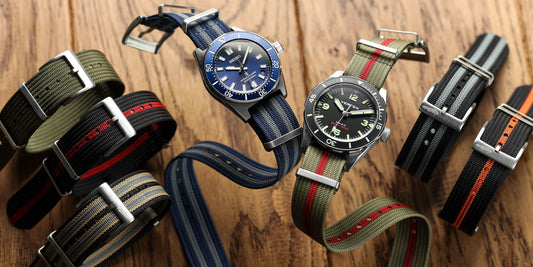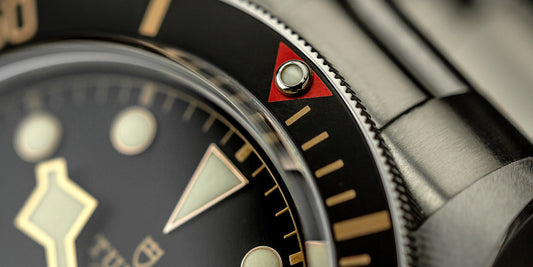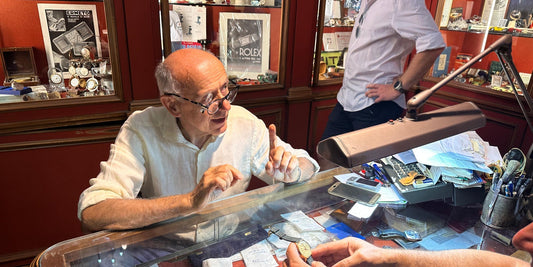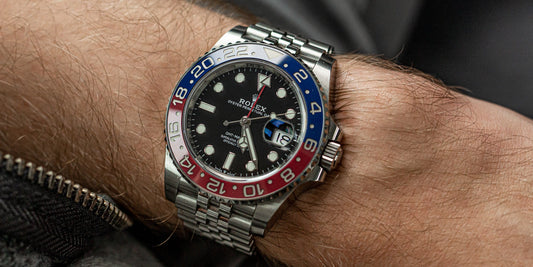There were so many highlights of the Watches and Wonders show that it’s hard to single them all out, but here are just a few…in no particular order.
It was no real surprise that everyone seemed to focus on Rolex, as this year there was a special anniversary: 60 years of Daytona, the archetypal racing watch. To celebrate, there was a special display cataloguing the entire history of the Daytona (with one of the revered ‘Paul Newman’ models exhibited). If there’s one watch you’d want to take away from the show, there it was, right there.

Of the new models, the Daytona gained a display case back and an updated movement, as well as a new blue dial with a brown bezel (which actually looks black in person). Brown seemed to be one of the colours of the show actually, but we’ll get back to that.

Rolex also launched the 1908 collection, a dress watch, and if you’re wondering why 1908, this was when the Rolex name first appeared on a dial. But the Rolex that got me most excited was the Yacht Master in titanium; a watch that’s been crying out for this treatment for years. Not only does it look great in that darker titanium shade, but it’s also only Rolex’s second titanium watch after the Deep Sea. I loved it, whereas) I didn’t really get overexcited by the 40mm Explorer – to my eyes it's not really any different to the 39mm version, despite what many people say.

Tudor came out with some great releases, including the Black Bay 54 (harking back to the original 1954 model) and we saw some wholesale changes across the range including a new handset and new bracelets, all of which looked good, as well as some new movements from the brand-new factory.
Many people raved about the Black Bay GMT Pepsi with Opaline dial, but my favourite Tudor was another brown watch: the Royal. It’s Tudor’s interpretation of the President watch (Day Date) and there’s something that looks absolutely magnificent about it, especially in gold and brown. It’s amazing how much your tastes change over the years, as this is a watch that I wouldn’t have been seen dead wearing a few years ago. I think it’s called getting old.
Further proof of this is how much I liked the Patek Philippe Calatrava 24-Hour display travel time watch. Patek’s take on a GMT was the brand at its finest, complete with exquisite detailing, featuring a blue dial and strap in a 42mm case. By Patek standards, it was also pretty good value at around £50K.
Perhaps what I got out of Watches and Wonders most of all was an appreciation of ‘haute horlogerie’ that I’d never really properly cultivated before. I’ve admired these watches from a distance previously but always in an abstract sense. Now, having handled some of the very finest watches out there, I have a deep and profound admiration for them.
I’m talking about watches such as the Vacheron Constantin Overseas Moonphase Retrograde Date: one of the most breathtakingly beautiful watches of the show, featuring the most romantic complication of all. It’s a watch that I found myself staring at for hours, complete with gold rotor visible through the caseback.
The Patrimony Retrograde Day-Date was in the same mould; this time with a salmon pink sunburst dial within a platinum case. But there’s one of the watches in this elevated category that really stood out, which we’ll talk about separately in the top highlights.
The other really interesting aspect of the show was connecting with brands that I was never previously familiar with, or especially into. One example of that was Hermes, a company that I thought was mostly known for making scarves. So how come I found myself so keen on their new family of sports watches: the H08? This model has actually been around for a little while, but now it comes in a new pressed carbon case with a collection of coloured straps that match the markings on the dial. The shape and the overall look are really contemporary, I’m into the grainy carbon, and I fell in love with the 39mm cushion case. A confession: I own an Apple watch and this Hermes watch actually reminded me of it quite strongly, but as Hermes has officially collaborated with Apple previously, I doubt that they will be too offended. Yours for around 7000 Euros, which didn't strike me as outrageous for what you get.
Keeping with the French theme, perhaps the brand that surprised me most was Bell and Ross, exhibiting at Geneva for the first time. It’s a brand that I’ve wanted to like for a long time because of their aviation ethos, but I’ve always struggled with the overtly industrial design. Now, as if by magic, they are making it much easier; flattening off some of the edges to make watches that are smoother and easier to wear, while losing nothing of the aircraft DNA. There was a huge collection of new Bell and Ross watches, some still under embargo, but trust me: they’re all great. The free publicity generated by President Emmanuel Macron trying to subtly slip his off during a speech about poverty is the sort of gilt-edged endorsement that money can’t really buy.
Baume et Mercier was another brand I enjoyed getting to know properly for the first time, as they introduced the latest iterations of the Riviera model to celebrate its 50th birthday. The blue watches in particular – another recurring colour of the show, alongside brown – really spoke to me, bringing the sparkle of the Cote d’Azur to my wrist as it tried it on, complete with wave patterns integrated within the dial.
And I even loved the (slightly Nautilus-like) Piaget Polo Perpetual Calendar Ultra Thin: a brand that’s very rarely been on my radar, given their traditional focus on jewellery. We shouldn’t forget about Jaeger-LeCoultre either. When you spend time with a Reverso, you really appreciate the beauty and engineering behind each one, while understanding the thinking behind the ‘golden ratio’ – a theory that describes perfect proportions. There were three new models to the Reverso collection this year, with the small seconds version perhaps being my favourite in classic silver. The JLC stand was one of the best of the show, as it showcased both a watchmaking display as well as strap-making display thanks to their relationship with Argentine leather firm Casa Fagliano. They even had their own pastry chef, Nina Metayer, who recreated the golden ratio in eatable form.
My other favourite? The Lange & Sohne Odysseus Chronograph, with a big day-date display inspired by the flickering black and white departure boards that you used to see at airports, as well as a big red chronograph hand that uses the main dial. The functionality is complex yet intuitive, and the whole design hangs together cohesively in a way that’s distinctly German. I really enjoyed getting to Know the company better – but how can you not warm to any copy that invites you to their stand to enjoy “a good German beer”?

From a brand I didn’t know especially well before to one that I did: it was a pleasure to drop by the Panerai stand to see the latest Italian dive watches. There was nothing too revolutionary there, but we did see evidence of a trend to make the watches more wearable and appeal to a wider cross-section of the watch-buying public – a general theme of the show. One example was a new gold Radiomir, now available in 40mm size.
The Radiomir was the clear focus of the latest collection, with an annual calendar watch being the biggest novelty. Both stick with a 45mm case size, in gold and platinum – gold is the cheapest option at 40,000 Euro, which gives you a good idea of the brand’s continued aspirations at the top end.
Spend less though (12,000 Euro) and you can get the new California featuring Roman numerals, made from recycled e-steel with a new unbranded green dial. There’s a brunito finish on the case, which describes the distressed and scratched look that stealth divers used to favour, in order to lurk undetected in the depths. The Ottogiorni Radiomir is yours for less than 10,000 Euros, and the name describes the eight days of power reserve that you get from the manual wind movement. It’s one of the watches in the show that I could imagine spending my own money on – which by definition, is a reasonably limited pool, although not for lack of trying…
There are some though that pass that test, and they will be the focus of a separate feature; our very top highlights of the Geneva Show.

Last but not least, I was mesmerised by the latest Grand Seiko watches, including the Tentagraph – the company’s first Chronograph that forms part of the Evolution 9 collection, as well as new watches with dials inspired by Japanese lakes and mountains. Grand Seiko is one of the brands that remains most loyal to its classical DNA: the biggest triumph of the Tentagraph is that it’s a complicated watch that manages to look clean and uncomplicated at the same time. The ‘Lake Suwa’ titanium watch, with an archetypally blue dial, represents great value for what it is at around 10,000 Euros – yet another watch that I would have loved to walk away with.

















